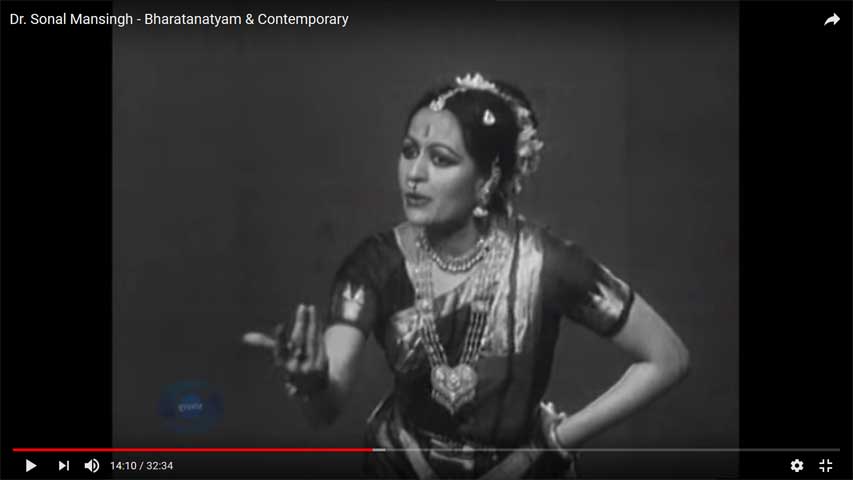Back then, the rock (indeed Rock-ing) era where dancers were still dancing in their own tuned and not corrected to pose better by the photographers, their postured were captured as sculptures on the stones. Each sculpture we see is a dancer itself. Dance and heritage goes hand in hand, how to see what was in the past and bring the preset, historic sites such as Temples, Baradaris and Manch are only building blocks which reminds us of the roots. There were those sites where scholars such as Padma Subramanyam, Nataraja Ramakrishna researched and bought innovations from the history and implemented into current context in the dance which we see now. So, here are few heritage sites we bring in , which every dancer should visit at least once in their lifetime.
1. Brihadishvara Temple (Tanjavur)
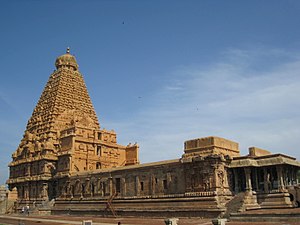
Brihadishvara Temple, also called Rajarajesvaram or Peruvudaiyar Koyil, is a Hindu temple dedicated to Shiva located in Thanjavur, Tamil Nadu, India. It is one of the largest South Indian temples and an exemplary example of a fully realized Dravidian architecture.
It is called as Dhakshina Meru (Meru of south0.Built by Raja Raja Chola I between 1003 and 1010 AD, the temple is a part of the UNESCO World Heritage Site known as the “Great Living Chola Temples”.
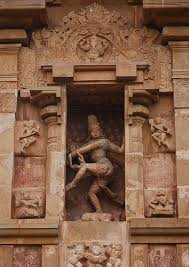
The original monuments of this 11th century temple was built around a moat. It included gopura, the main temple, its massive tower, inscriptions, frescoes and sculptures predominantly related to Shaivism, but also of Vaishnavism and Shaktism traditions of Hinduism. The temple was damaged in its history and some artwork is now missing. Additional mandapam and monuments were added in centuries that followed. The temple now stands amidst fortified walls that were added after the 16th century.Shiva’s Tripurantaka form in different postures is depicted corresponding to these sculptures. Above floors, the sri-vimana towers above in thirteen storeys (talas).
The upper storey corridor wall of the aditala is carved with 81 of the 108 dance karanas – postures of Natya Sastra. This text is the basis of the Bharathanatyam, the classical dance of Tamil Nadu. The 27 unrepresented karanas are blank blocks of stone, and it is unclear why these were not carved. The 81 postures carved suggest the significance of this classical Indian dance form by early 11th century.
2. Shore Temple, Mahabalipuram

The Shore Temple is so named because it overlooks the shore of the Bay of Bengal. It is a structural temple, built with blocks of granite, dating from the 8th century AD. At the time of its creation, the site was a busy port during the reign of Narasimhavarman II of the Pallava dynasty.
As one of the Group of Monuments at Mahabalipuram, it has been classified as a UNESCO World Heritage Site since 1984. It is one of the oldest structural (versus rock-cut) stone temples of South India.
The Mamallapuram Dance Festival is held every year during Dec-Jan in Mamallapuram, Tamil Nadu. This dance festival is organised by the Department of Tourism, Govt. of Tamil Nadu. Exponents of Bharatanatyam, Kuchipudi, Kathak, Odissi, Mohini Attam and Kathakali perform against this magnificent backdrop of the Pallava rock sculptures. It is a vibrant festival of dance where enormous audience enjoys this one-month long festival
3. Thillai Nataraja Temple, Chidambaram
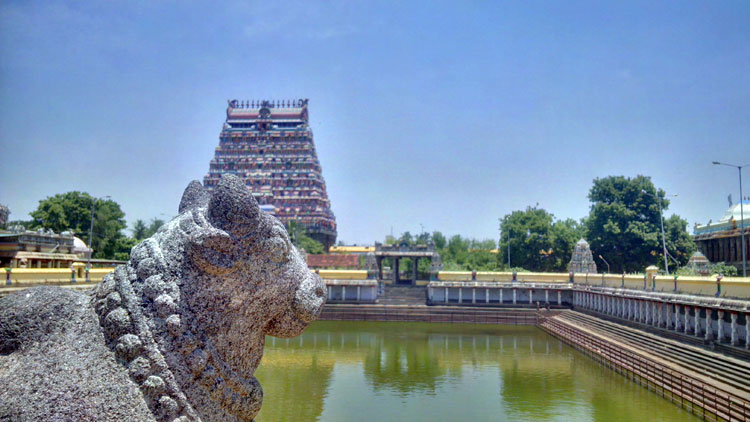
Nataraja Temple also referred to as the Chidambaram Nataraja temple or Thillai Nataraja temple, is a Hindu temple dedicated to Nataraja, Shiva as the lord of the dance, in Chidambaram, Tamil Nadu, India. The temple has mythical roots and a Shiva shrine existed at the site when the town was known as Thillai. Chidambaram, the name of the city and the temple literally mean “atmosphere of wisdom” or “clothed in thought”, the temple architecture symbolizes the connection between the arts and spirituality, creative activity and the divine.
 The temple wall carvings display all the 108 karanas from the Natya Shastra by Bharata Muni, and these postures form a foundation of Bharatanatyam, a classical Indian dance Nataraja Shiva and his “dance of bliss” is an ancient Hindu art concept. It is found in various texts such as Tatva Nidhi which describes seven types of dance and their spiritual symbolism, Kashyapa Silpa which describes 18 dance forms with iconographic details and design instructions, as well as Bharata’s ancient treatise on performance arts Natya Shastra which describes 108 dance postures among other things. The eastern gopuram features the 108 reliefs of Natya Shastra dance postures (22 cm each in a separate niche) and faces the sanctum. The eastern gopuram is renowned for its complete enumeration of 108 poses of Indian classical dance – Bharathanatyam, detailed in small rectangular panels along the passage that leads to the gateway.
The temple wall carvings display all the 108 karanas from the Natya Shastra by Bharata Muni, and these postures form a foundation of Bharatanatyam, a classical Indian dance Nataraja Shiva and his “dance of bliss” is an ancient Hindu art concept. It is found in various texts such as Tatva Nidhi which describes seven types of dance and their spiritual symbolism, Kashyapa Silpa which describes 18 dance forms with iconographic details and design instructions, as well as Bharata’s ancient treatise on performance arts Natya Shastra which describes 108 dance postures among other things. The eastern gopuram features the 108 reliefs of Natya Shastra dance postures (22 cm each in a separate niche) and faces the sanctum. The eastern gopuram is renowned for its complete enumeration of 108 poses of Indian classical dance – Bharathanatyam, detailed in small rectangular panels along the passage that leads to the gateway.
[adrotate group=”9″]
4. Konark Sun Temple, Konark

Konark Sun Temple is a 13th-century CE sun temple at Konark about 35 kilometres (22 mi) northeast from Puri on the coastline of Odisha, India. The temple is attributed to king Narasingha Deva I of the Eastern Ganga Dynasty about 1250 CE.
Dedicated to the Hindu God Surya, what remains of the temple complex has the appearance of a 100-foot (30 m) high chariot with immense wheels and horses, all carved from stone. Once over 200 feet (61 m) high, much of the temple is now in ruins, in particular, the large shikara tower over the sanctuary; at one time this rose much higher than the mandapa that remains. The structures and elements that have survived are famed for their intricate artwork, iconography, and themes, including erotic kama and mithuna scenes. Also called the Surya Devalaya, it is a classic illustration of the Odisha style of Architecture or Kalinga Architecture.
On the east side of the main temple is the Nata Mandira (lit. dance temple). It stands on a high, intricately carved platform. The relief on the platform is similar in style to that found on the surviving walls of the temple. According to historical texts, there was an Aruna Stambha (lit. Aruna’s pillar) between the main temple and the Nata Mandira, but it is no longer there because it was moved to the Jagannatha at Puri sometime during the troubled history of this temple. According to Harle, the texts suggest that originally the complex was enclosed within a wall 865 feet (264 m) by 540 feet (160 m), with gateways on three sides.
[adrotate group=”9″]
5. The Rasmancha, Bishnupur
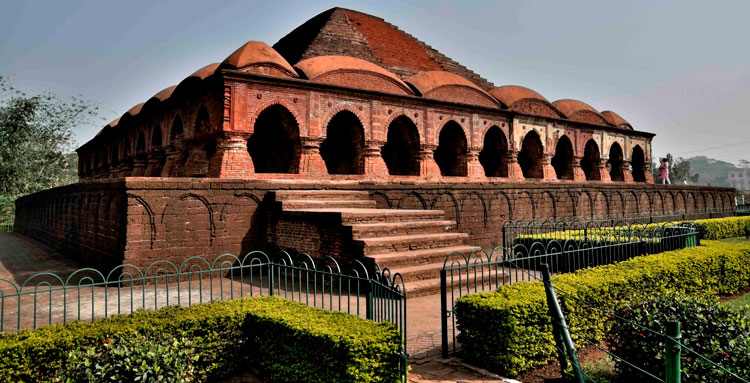
The Rasmancha is a historical building located at Bishnupur, Bankura district, West Bengal, India. It was commissioned by Mallabhum king Hambir Malla Dev (Bir Hambir) in 1600 CE. Length and breadth of this temple is 24.5 meter and the height is 12.5 meter.
The base or altar of the temple is made of laterite stone and the upper part is made with bricks. The upper structure looks like a pyramid with dance poses engraved in Mallabhum architecture. Middle part resembles Bengali huts and the arches of the lower part resemble Islamic architecture.
During the Vaishnava Ras Festival, all the Radha Krishna idols of Bishnupur town used to be brought here to be worshipped by the citizens with godiya nritya being performed as an offering to the lord.. The annual festival was held till 1932.
6. Sarangapani Temple, Kumbakonam

Sarangapani Temple is a Hindu temple dedicated to Vishnu, located in Kumbakonam, Tamil Nadu, India. It is one of the Divya Desams, the 108 temples of Vishnu revered in Nalayira Divya Prabandham by the 12 poet saints, or Alwars. This temple is along Kaveri and is one of the Pancharanga Kshetrams.
The temple is believed to be of significant antiquity with contributions at different times from Medieval Cholas, Vijayanagar Empire and Madurai Nayaks. The temple is enshrined within a huge granite wall and the complex contains all the shrines and the water bodies of the temple. The Rajagopuram (the main gateway) has eleven tiers and has a height of 173 ft (53 m). The Potramarai tank, the temple tank, is located opposite to the western entrance of the temple.
In Bharatanatyam, a South Indian dance form, 108 karanas form the basic movements. Some of these karanas are sculpted around the walls of the temple. Similar sculptures are found in the Brihadeeswarar Temple in Thanjavur and Nataraja Temple in Chidambaram.
[adrotate group=”9″]
7. Ellora, Aurangabad
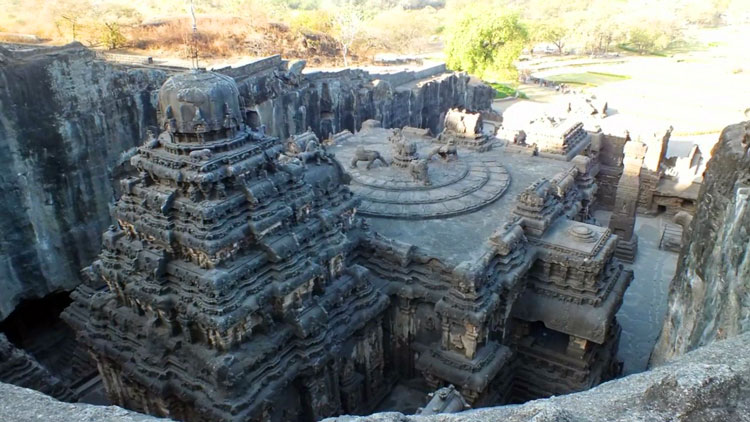
Ellora located in the Aurangabad district of Maharashtra, India, is one of the largest rock-cut monastery-temple cave complexes in the world, and a UNESCO World Heritage Site, featuring Buddhist, Hindu and Jain monuments, and artwork, dating from the 600-1000 CE period. Cave 16, in particular, features the largest single monolithic rock excavation in the world, the Kailasha temple, a chariot shaped monument dedicated to Shiva. The Kailasha temple excavation also features sculptures depicting the gods, goddesses and mythologies found in Vaishnavism, Shaktism as well as relief panels summarizing the two major Hindu Epics. The main hall of the Visvakarma cave is apsidal in plan and is divided into a central nave and side aisles by 28 octagonal columns with plain bracket capitals. In the apsidal end of the chaitya hall is a stupa on the face of which a colossal high seated Buddha in vyakhyana mudra (teaching posture). A large Bodhi tree is carved at his back. The hall has a vaulted roof in which ribs (known as triforium) have been carved in the rock imitating the wooden ones. The friezes above the pillars are Naga queens, and the extensive relief artwork shows characters such as entertainers, dancers and musicians.
The Dashavatara temple, or Cave 15, is another significant excavation that was completed sometime after Cave 14 (Ravan ki Khai, Hindu). Cave 15 has cells and a layout plan that is similar to Buddhist Caves 11 and 12, which suggests this cave was intended to be a Buddhist cave; however, the presence of non-Buddhist features, such as a Nrtya Mandapa (an Indian classical dance pavilion) at its entrance, indicated otherwise. According to James Harle, Hindu images have been found in Buddhist Cave 11, while many Hindu deities have been incorporated in Buddhist caves of the region. This overlap in disparate designs between Buddhist and Hindu caves may be due to the sites being worked on by the same architects and workers, or perhaps a planned Buddhist cave was adapted into a Hindu monument.
The Ellora Ajanta Dance Festival organised in the month of October generally focuses on the Kathak and Odissi forms of dance which are very popular in the country. The beautiful Kailasha temple in Maharashtra forms an essential part of the backdrop for this event and it is a privilege to view this beauty adorning such a program.
8. Virupaksha Temple, Hampi

Virupaksha Temple is located in Hampi in the Ballari district of Karnataka, India. It is part of the Group of Monuments at Hampi, designated as a UNESCO World Heritage Site. The temple is dedicated to Virupaksha, a form of Shiva. The temple was built by Lakkan Dandesha, a nayaka (chieftain) under the ruler Deva Raya II of the Vijayanagara Empire. Hampi, capital of the Vijayanagara empire, sits on the banks of the Tungabhadra River. Virupaksha Temple is the main centre of pilgrimage at Hampi, and had been considered the most sacred sanctuary over the centuries. It is intact among the surrounding ruins and is still used in worship.
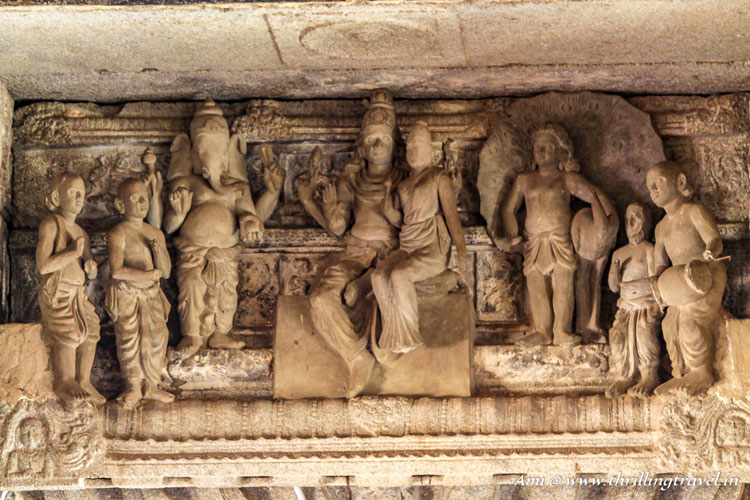
The temple is dedicated to Lord Shiva, known here as Virupaksha, as the consort of the local goddess Pampadevi who is associated with the Tungabhadra River. There is also a Virupakshini Amma temple (mother goddess) in a village called Nalagamapalle, Chittoor district, Andhra Pradesh, approximately 100 km from Tirupati. Krishnadevaraya, one of the famous king of the Vijayanagara Empire was a major patron of this temple. The most ornate of all structures in the temple, the central pillared hall is believed to be his addition to this temple. So is the gateway tower giving access to the inner courtyard of the temple. Inscriptions on a stone plaque installed next to the pillared hall explain his contribution to the temple. It is recorded that Krishna Devaraya commissioned this hall in 1510 AD to mark his accession. He also built the eastern gopuram.
[adrotate group=”9″]
The Hampi Festival is scheduled for 3 days during the first week of November. The celebrations typically packed with shows of music, dance puppet shows fireworks and a pomp procession as the grand finale showcasing the cultural richness of the place.
9. Taramati Baradari, Hyderabad
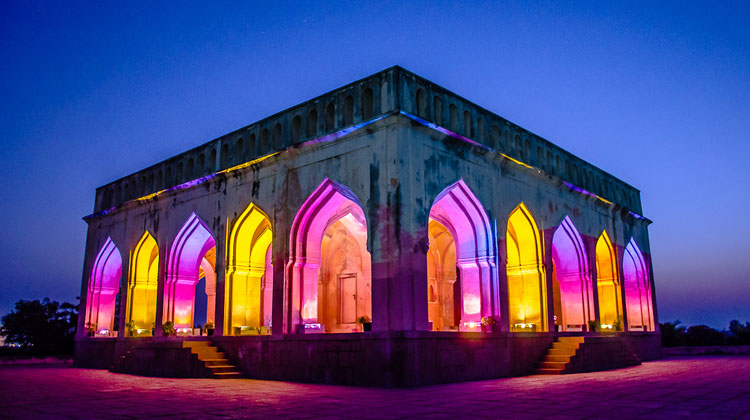
Taramati Baradari is a historical sarai as part of Ibrahim Bagh, a Persian style garden built during the reign of Ibrahim Quli Qutub Shah, the fourth Sultan of Golconda. The tourism department promotes the location by romantic stories linking the then-Sultan with a courtesan named Taramati.
One such story goes that during the reign of Abdullah Qutb Shah, he used to hear Taramati’s voice as she sang for travellers at the Serai, while he sat two kilometres away at Golconda fort. Her melodious voice was carried by the breeze, reaching the prince’s ear at the fort. There is no recorded report of the same. Another fable tells of two ravishing dancing sisters, Taramati and Premamati, who danced on ropes tied between their pavilion and the balcony of the king and patron, Abdulla Qutub Shah.
10. Khajuraho Temple, Madhya Pradesh
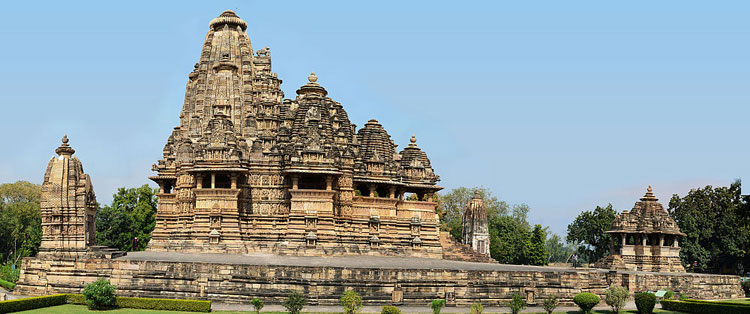
The Khajuraho Group of Monuments is a group of Hindu temples in Chhatarpur, Madhya Pradesh, India, about 175 kilometres (109 mi) southeast of Jhansi. They are one of the UNESCO World Heritage Sites in India. The temples are famous for their nagara-style architectural symbolism and their sculptures. Most Khajuraho temples were built between 950 and 1050 by the Chandela dynasty. An overall examination of site suggests that the Hindu symbolic mandala design principle of square and circles is present each temple plan and design. Further, the territory is laid out in three triangles that converge to form a pentagon. Scholars suggest that this reflects the Hindu symbolism for three realms or Trilokinatha, and five cosmic substances or Panchbhuteshvara. The temple site highlights Shiva, the one who destroys and recycles life, thereby controlling the cosmic dance of time, evolution and dissolution.
The Khajuraho Dance Festival is held every year in February. It features various classical Indian dances set against the backdrop of the Chitragupta or Vishwanath Temples.
[adrotate group=”9″]
11. Maharaj Kalka-Bindadin ki Dyodhi, Lucknow
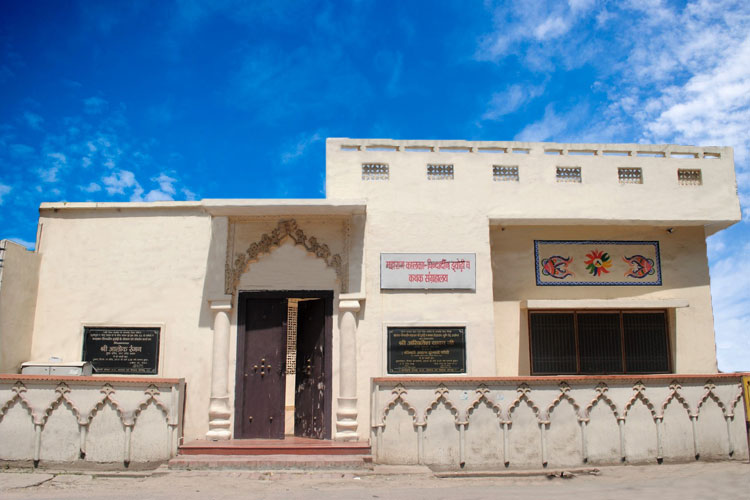
A courtyard with a three-dimensional mural of dancers and a well opens into the main museum. This museum is the ancestral home of Birju Maharaj, which was given to his ancestors by Wajid Ali Shah, a great patron of arts and culture in the city of Nawabs, Lucknow. The main hall has a series of framed photographs on display of Birju Maharaj’s performances with maestros like Girija Devi.
There is also an old camera on display that belonged to Birju Maharaj along with his ghungurus. Busts of Shambhu Maharaj, Lachchhu Maharaj and Achchhan Maharaj are also on display, along with a poshak that was worn by Maharaj Kalka Bindadin, considered the architect of the present form of the Lucknow Gharana, in one of his performances. A kiosk also offers information about the family tree of Birju Maharaj.
The Kathak Museum has memorabilia on display in the room of rest, kitchen and prayer room that belonged to Birju Maharaj. There is a stairway with photographs on display, drawing an engaging trajectory of his performances.
The library on the top floor is not open to the public as yet but will be in due course. Seminars are often held and Birju Maharaj also graces the museum to perform, occasionally. The museum also has two films on the significance of the Lucknow Gharana and the lineage of Birju Maharaj.
[adrotate group=”9″]
Now as you know about these historic sites, travel around and explore and spread the essence of impact history reflects into an art form which makes it a continuous process to evolve. The next time you visit these sites, strike a dance pose a store the memory of those dancers of these enclaves.









